|
50 (Middle East) Commando - East Mediterranean
An Integral Part of 'Layforce'
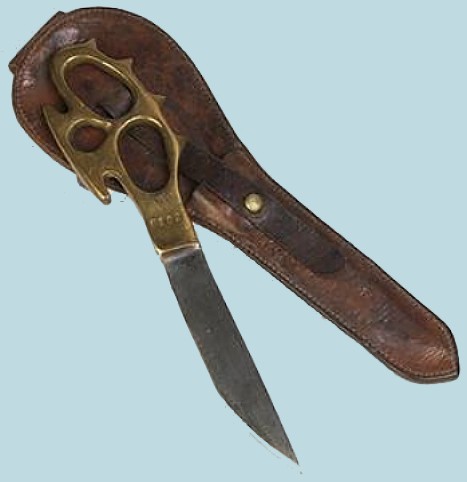
Background
In 1940, there
were proposals to set up a Commando force in the Middle East from serving
soldiers already in the theatre of operations. Early plans to raise 3
Indian Commandos and one from the Polish forces did not materialise.
However, two Commando units were raised from within British forces and a
third from Palestinian sources officered by the British, including British
Non Commissioned Officers (NCOs). This account is about one of the 2
British Commandos which became known as No 50 (Middle East) Commandos. The
other was 52 (Middle East) Commando. They later became part of a larger
Commando force named "Layforce" after its commanding officer Robert
Laycock. It drew on 'A' Troop from
No. 3 Commando,
No. 7,
No. 8 (Guards) Commando and
No. 11 (Scottish) Commando.
[Photo; Knuckle-duster knife
produced during 1940-41 for use by members of 50, 51 and 52 Commandos.
These three Commandos were raised in the Middle East and the knives were
made locally in Egypt. The hilt of the knife takes the form of a
substantial brass knuckleduster, on to which the single-edged blade is
brazed. It seems likely that more were produced than were strictly
required by the three Commando units, as numerous examples survive.
Courtesy of Imperial War Museum. © IWM (WEA 659)].
Major George
Young of the Royal Engineers, was tasked to raise the 2 British Commandos.
Before the outbreak of the Second World War, he, along with several other
officers, was posted to Egypt to plan, train and undertake, if required,
operations which would disrupt and hamper the prospective enemy. One such
operation was the destruction of oilfields in Rumania, plans for which had
been drawn up as early as the summer of 1939 because of their strategic
importance to enemy forces. Young visited the site and made contact with a
group of British engineers working there.
Back in Egypt,
a Field Company was selected from the Royal Engineers to train for this
task. Preparations moved briskly and in May 1940 they were posted to
Chanak in Turkey, which was much closer to their intended targets. Dressed
in civilian clothes, the men worked on improvements to local roads and the
harbour. However, by the spring of 1940 and the evacuation of the Allied
expeditionary force from Dunkirk, the Royal Engineers returned to Egypt
due to sensitivity over Turkey’s neutrality and Rumania’s leaning towards
Germany and her Axis allies.
Young was now
put in charge of raising the Middle East Commando assisted by an officer
from the Durham Light Infantry, Captain Harry Fox-Davies.
No 50 Commando
-
Recruitment
By July 1940,
No 50 Middle East Commando had a provisional strength of 371 all ranks. It
comprised an HQ and 3 Troops, each of 4 Sections, under the command of a
Section Officer with 25 other ranks under his command. A Royal Army
Medical Corps (RAMC) doctor and 3 orderlies were attached together with a
Royal Army Ordnance Corps (RAOC) sergeant and 2 interpreters they could
call upon as required.
With HQ
restrictions on the redeployment of tank crews, engineers and men from the
technical arm of their forces, all ranks were recruited from the infantry,
with a maximum of 10 all ranks from any single Battalion or Regiment.
However, some men were recruited from the 1st Cavalry Division, then in
Palestine. They were mainly from Yeomanry Regiments still using horses,
although conversion to armour would soon follow. To these were added a
number of Spaniards who left Spain after the Republican Forces were
defeated by Franco’s army during the Civil War.
They originally
crossed the Pyrenees into France with the intent of enlisting in the
French Army to carry on the fight against the Fascists. Most were sent to
Syria, then a French mandate, while others found themselves in the French
Foreign Legion. With the fall of France and the creation of the Vichy
Government, Syria fell into line with Vichy and again fearing that their
safety, the Spaniards commandeered a couple of vehicles and crossed the
border into Palestine, where they declared their intent to fight under the
control of the British. The 63 men were interviewed by Young and
Fox-Davies in Moascar. The Spaniards were regarded as a valuable asset and
were accepted into the ranks of the Commandos.
Training
By August 1940,
the Commandos were based at Geneifa in Egypt and training had begun. Where
possible, sections comprised men from the same Regiment. Their primary
task was to mount raiding operations on enemy coastlines which, with Italy
now fighting on the side of the Axis powers, would likely include the
Libyan coast as a prime target.
The men were
all trained soldiers, but for the challenging tasks ahead, more rigorous
training was required in endurance and physical fitness. Each man was
expected to undertake three 30 mile marches, in full kit, within the space
of 24 hours on consecutive days! The use of water and consumption of food
were strictly controlled. Military discipline would be invoked if
permission from an Officer or NCO was not obtained in advance. Such
rigorous controls were necessary because of the arid terrain, extremely
high day-time temperatures and remoteness from support and supplies. It
was envisaged that most work would be undertaken during the hours of
darkness, with the hottest parts of the day, laid up, under shade.
They had to be
self-sufficient with each man carrying enough food and water for the
duration of each operation. They unsuccessfully experimented with dried
beef but settled on the ubiquitous Bully Beef with packs of rice, dates,
limes, army biscuits, chewing gum, tea and sugar. A full bottle of water,
along with a water purification kit, allowed them to replenish their
bottles if they came upon a water source.
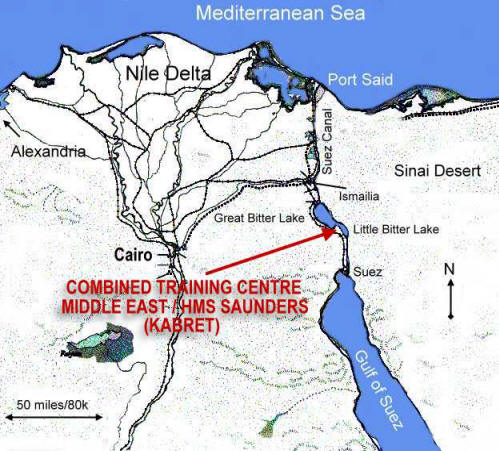 Just
before Italy’s declaration of war in June 1940, Lt. General Maitland
Wilson, known to many as Jumbo, explored the feasibility of raising a unit
of paratroops to operate behind enemy lines, but with parachutes in short
supply in this theatre of war, the idea was shelved. Landing craft for
training exercises were similarly scarce, so they made do with a few old
whalers and rafts that they could improvise. They commenced the nautical
part of their training at the
Middle East Combined Training
Centre
on the Bitter Lakes, which formed part of the Suez Canal. Just
before Italy’s declaration of war in June 1940, Lt. General Maitland
Wilson, known to many as Jumbo, explored the feasibility of raising a unit
of paratroops to operate behind enemy lines, but with parachutes in short
supply in this theatre of war, the idea was shelved. Landing craft for
training exercises were similarly scarce, so they made do with a few old
whalers and rafts that they could improvise. They commenced the nautical
part of their training at the
Middle East Combined Training
Centre
on the Bitter Lakes, which formed part of the Suez Canal.
[Maps of the training area opposite and
below].
All Private
soldiers now assumed the new rank of Raider and uniforms were adapted for
rough service. Hard rubber soles were added to regular issue boots and
regular issue shorts gave way to khaki drill trousers. The wardrobe
changes included a bush type jacket and a hat similar to that worn by
Australian forces, although some opted for the old pith helmet.
The weapon for
other ranks was the standard issue .303 SMLE rifle with Bren gun teams,
NCOs and Officers carrying revolvers. Thompson sub-machine guns were
issued to NCOs. The Fairbairn-Sykes fighting knife, not yet in general
service with the Commandos, was a fearsome weapon with a knuckle duster on
the handle. This became the unofficial badge for the Middle East Commandos
and was known as a Fanny.
All Commandos
received training in the use of explosives for demolition work, an
essential part of many clandestine operations behind enemy lines. Not all
were proficient, at least in the early period, because of constraints on
time and supplies of explosives but the objective was for all to be able
to set simple charges on land and underwater.
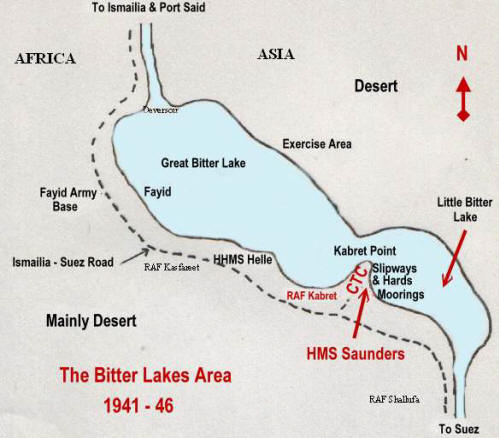 In
October 1940, Young was promoted Lt. Colonel and Fox-Davies stepped up to
Major becoming 2nd in command. Training was still going on apace until all
had fully completed the Commando training course. Back at MEHQ, plans to
expand the Commandos continued with the previously 3 Indian Commandos
further augmented by a 4th British Commando; but once again, these plans
did not come to fruition. In
October 1940, Young was promoted Lt. Colonel and Fox-Davies stepped up to
Major becoming 2nd in command. Training was still going on apace until all
had fully completed the Commando training course. Back at MEHQ, plans to
expand the Commandos continued with the previously 3 Indian Commandos
further augmented by a 4th British Commando; but once again, these plans
did not come to fruition.
Early Deployments
After the
Italians crossed the border into Egypt on the 13th September 1940, the
Commandos were deployed, even although only part of No 50 was operational.
In mid-October, they were ordered to attack Bomba to the east of Benghazi
on the north African coast, a recently established Italian seaplane base.
It had been already been attacked by aircraft of the Fleet Air Arm during
August but the objective now for No 50 Commando was the destruction of the
base.
At Geneifa on
the Suez Canal, Young and Fox-Davies planned the operation with both
Captains of their escorting ships, the destroyers HMS Decoy and HMS
Hereward. With the aid of air photography, maps and a mock-up of the
target, they finalised their plans and several rehearsals were carried out
to familiarise each man with his particular tasks. They were to land at
00.00 hours, guided in by an RN submarine and then to attack the tents and
huts of the Italian garrison. Meanwhile, Royal Navy motor launches would
attempt to destroy the moored, Italian seaplanes, using rockets.
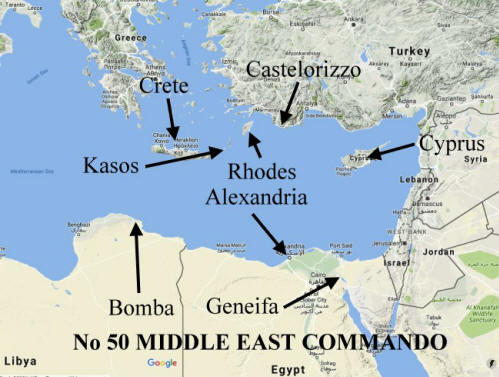 On
the night of the 28/29th October, in great secrecy, the Commandos boarded
their escort destroyers moored in the Great Bitter Lake and set off for
Port Said. For security reasons, they were confined below deck, out of the
sight of any prying eyes. Just when the weeks of planning and rehearsals
were about to pay off, the operation was cancelled when the Italians
declared war on Greece. On
the night of the 28/29th October, in great secrecy, the Commandos boarded
their escort destroyers moored in the Great Bitter Lake and set off for
Port Said. For security reasons, they were confined below deck, out of the
sight of any prying eyes. Just when the weeks of planning and rehearsals
were about to pay off, the operation was cancelled when the Italians
declared war on Greece.
[Map of Eastern Mediterranean courtesy of
Google Map Data 2017].
The raiding
force was recalled to Alexandria over concerns that both Greece and Crete
would be invaded, the latter occupying a strategically important position
in that area of the Mediterranean.
Many of the
Commandos were bitterly disappointed by this turn of events after so much
planning and training. However, unbeknown to anyone at the time, this was
only the start of a period of cancelled Layforce operations. On the night
of 16/17th January 1941, the Commandos embarked on a raid of the
Dodecanese island of Kasos (Operation Blunt), but this was cancelled just
as landing vessels were being lowered into the water and a second attempt
on 17/18th February was also aborted.
Admiral of the
Fleet, Sir Andrew Cunningham, Commander-in-Chief Mediterranean, had his
sights on the island of Castelorizzo, about eighty miles east of Rhodes
and just three miles off the Turkish coast. He wanted a secure motor
torpedo boat base to support future operations against the Italians in the
Dodecanese.
At
Geneifa on the Suez Canal, Young and Fox-Davies planned the operation with
both Captains of their escorting ships, the destroyers HMSs Decoy
and Hereward. With the aid of air photography, maps and a mock up
of the target, they finalised their plans and several rehearsals were
carried out to familiarise each man with his particular task. They were to
land at 00.00 hours, guided in by a RN submarine and then to attack the
tents and huts of the Italian garrison. Meanwhile, Royal Navy motor
launches would attempt to destroy the moored, Italian sea planes, using
rockets.
On the night of the 28/29th
October, in great secrecy, the Commandos boarded their escort destroyers
moored in the Great Bitter Lake and set off for Port Said. For security
reasons they were confined below deck, out of the sight of any prying
eyes. Just when the weeks of planning and rehearsals was about to pay off,
the operation was cancelled when the Italians declared war on Greece. The
raiding force was recalled to Alexandria over concerns that both Greece
and Crete would be invaded, the latter occupying a strategically important
position in that area of the Mediterranean.
Many of the
Commandos were bitterly disappointed by this turn of events after so much
planning and training. However, unbeknown to anyone at the time, this was
only the start of a period of cancelled Layforce operations. On
the night of 16/17th January 1941, the Commandos embarked on a
raid of the Dodecanese island of Kasos (Operation Blunt), but this was
cancelled just as landing vessels were being lowered into the water and a
second attempt on 17/18th February was also aborted.
Admiral of
the Fleet, Sir Andrew Cunningham, Commander-in-Chief Mediterranean, had
his sights on the island of Castelorizzo, about eighty miles east of
Rhodes and just three miles off the Turkish coast. He wanted a secure
motor torpedo boat base to support future operations against the Italians
in the Dodecanese.
Operation Abstention - "Confused,
Incompetent, Inept and a Mess"
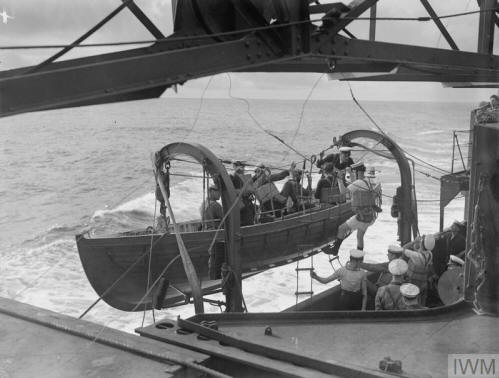 On
the evening of the 23rd/24th February 1941, 200 men set off for
Castelorizzo aboard HMS Decoy and HMS Hereward, accompanied by escorts
including an Australian cruiser. Operation Abstention was underway. Each
of the destroyers carried 5 whalers to carry the men, their supplies and
ammunition ashore. These craft were not as versatile as landing craft, so
supplies were broken down into easy to man-handle loads. The gunboat, HMS
Ladybird, carried 24 Royal Marines and two agents from the Special
Operations Executive (SOE) were embedded within the British forces. On
the evening of the 23rd/24th February 1941, 200 men set off for
Castelorizzo aboard HMS Decoy and HMS Hereward, accompanied by escorts
including an Australian cruiser. Operation Abstention was underway. Each
of the destroyers carried 5 whalers to carry the men, their supplies and
ammunition ashore. These craft were not as versatile as landing craft, so
supplies were broken down into easy to man-handle loads. The gunboat, HMS
Ladybird, carried 24 Royal Marines and two agents from the Special
Operations Executive (SOE) were embedded within the British forces.
[IWM 1941 photo
of an RN whaler. © IWM (A 6079)].
However,
there was a major flaw in the planning of the operation - the Commandos
had not been involved. This was a major error clearly demonstrating
that some officers did not understand the vital need for joint planning in
Combined Operations. It was the only way to achieve the high level of
commitment, cooperation, communications, coordination and mutual
confidence needed to achieve success.
Issues the
Commandos might have raised, had they been consulted, included; 1) their
dual role as an amphibious assault/invading force and an occupying force
with defensive responsibilities for which they were not trained, 2) the
type of craft to transport them and their supplies from their mother ship
to the shore were not suitable for the task and too few in number, 3)
their planned billets required them to march in full view of potential
spies and sympathisers who could report numbers, disposition, armaments
etc to the enemy on neighbouring islands.
Despite their
concerns about their lack of involvement in the planning process, the
Commandos struck up a good rapport with their Royal Navy counterparts on
the destroyers. They took an indirect course to the island, heading
initially for the Palestinian coast before steaming on to Categorize. The
short voyage took less than a day and aimed to reach the island by 03.00
hours on the 25th where a Royal Naval submarine would guide them into
their final position south-west of the island.
As
darkness fell, the Commandos emerged from below decks, made their final
preparations and proceeded to board the navy’s whalers. One of the landing
parties rowed into the harbour alerting the Italian garrison and causing
another boat to return to its mother ship. However, those in the harbour
swiftly dealt with the opposition and consolidated their position. The
remainder of the force landed successfully and prepared for the arrival of
the garrisoning force.
Before
daybreak, the naval forces of the 3rd Cruiser Squadron withdrew, leaving
only the Ladybird in support. She, at first light, shelled one of the
Commando's objectives, the Palecastro Fort, to which the Italian garrison
had withdrawn and one company of Commandos attacked the town itself,
overcame the sentries and took control. The Italian garrison put up very
little resistance.
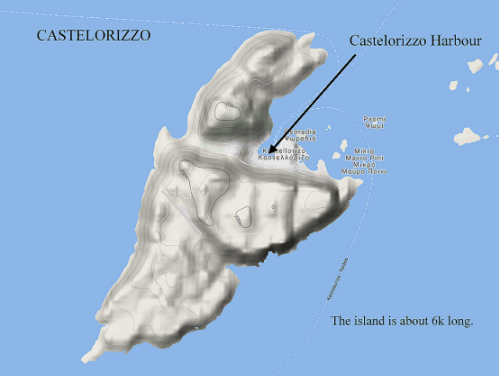 A
2nd company of Commandos, assisted by gunfire from the Ladybird, began
their assault on the fort whilst the remainder scaled the heights at the
flanks of the fort to cut off any attempted escape. The Italians,
uncharacteristically, resisted strongly but, by 10.00 hours, the fort was
finally under Commando control. Although Italian communications had been
destroyed early in the landing, they had alerted their compatriots on
other islands of their predicament. A
2nd company of Commandos, assisted by gunfire from the Ladybird, began
their assault on the fort whilst the remainder scaled the heights at the
flanks of the fort to cut off any attempted escape. The Italians,
uncharacteristically, resisted strongly but, by 10.00 hours, the fort was
finally under Commando control. Although Italian communications had been
destroyed early in the landing, they had alerted their compatriots on
other islands of their predicament.
The Italians
responded with unexpected vigour by shelling and bombing the small British
invading force. The British plans to land a company of the Sherwood
Foresters to form a garrison began to unravel as the Italian air and naval
activity made further landings impractical, forcing them to return to
their base in Cyprus, with the intention to return at a later date.
Meanwhile, the
Italians forced a landing on several beaches of Castelorizzo putting the
Commandos under pressure. Air attacks damaged HMS Ladybird which was
running short on fuel forcing them to return to Cyprus with her small
contingent of Royal Marines. This compounded the Commandos difficulties as
the Ladybird was their only radio link with the outside world. Throughout
the day, the Italian air force bombed and strafed the Commando positions,
killing 3 and wounding 7. Dusk brought a welcome respite... but not for
long. An Italian warship entered the harbour, lit up the Commandos
defensive positions with a searchlight and shelled the area forcing them
to withdraw. Although limited in weaponry, the Commandos shot down 2 enemy
bombers and forced a third into the sea. The crew were rescued by
islanders.
The Italians
followed up this initial bombardment by landing around 240 soldiers just
north of the harbour while their warships shelled the British positions.
The British navy intended to disrupt the Italian forces but were unable to
make contact with them. Rough seas provided a day of respite from naval
bombardment but the Commandos position was bad and likely to worsen. They
were isolated from supplies and reinforcements with no means of
communication and the plan envisaged they would be relieved within 24
hours of landing. They were provisioned accordingly. Food and drink could
be obtained locally but their ammunition was inadequate for a sustained
action.
Around this
time, the Small Fleets commander was replaced by Captain Egerton of HMS
Bonaventure due to illness.
When the
weather improved, the Italians resumed their troop landings, shelling and
air force sorties, increasing the pressure on the Commandos but causing no
serious casualties. In their turn, the Commandos unsuccessfully tried to
make contact with the Royal Navy by torch signals, but when their
batteries ran down they were left with matches as a light source. The
outlook was bleak and some no doubt felt abandoned with death or being
taken prisoner realistic prospects. The positions they held were well
spread out but they still managed to send out patrols to the beaches while
working parties went in search of Italian rations. The possibility of a
counter-attack was considered but not followed up due to time constraints.
With the
landing of more enemy troops from 2 destroyers in the harbour, the gravity
of the Commando's situation worsened when the Italians infiltrated the
Commando positions close to the cemetery. By midday the Commandos, which
had been split into 2 groups, one still covering their landing beach and
the other covering the cemetery, the town having been given up earlier,
had to withdraw to the high ground to avoid being overlooked by the enemy.
This pre-emptive redeployment proved fortuitous as the Italians landed
more troops on the Commando's landing beach while under covered by one of
their destroyers. As dusk fell, the Italians occupied a ridge some
three-quarters of a mile from the consolidated British positions and began
to advance towards them in sections. At around 300 yards they opened fire
with rifles and Bren guns. Nightfall brought this little action to a halt.
By this time
the Commandos had run out of food and water and all sources of water were
held by the Italians. With their reserve ammunition on a beach occupied by
the enemy, their ammunition was down to what the men carried in their
pouches. Their force was depleted by around 60 officers and men who were
missing from the main party. Morale was on the wane since there were no
sensible options open to them. It was only a matter of time when further
resistance would be futile. The 4th day was punctuated by ineffective
naval shell fire and bombs and their desperate situation seemed quite
hopeless when British destroyers from the relieving fleet, returned to the
island and made contact.
Aboard one of
the destroyers were men of the Sherwood’s, known affectionately as the
Notts and Jocks. When they landed the witnessed the results of the 4-day
action and found at least one dead Commando. However, they also made
contact with some of the men cut off from the main force of Commandos.
They occupied an isolated small plateau on the east of the island and
since their position was untenable, and with the failure of the garrison
to arrive from Cyprus, their only option was to withdraw.
Although most
men were able to re-embark some were left behind and became prisoners of
war. As the re-embarking men passed by the old Venetian fort on the way to
the dock, one of the SOE operatives called the operation ‘confused,
incompetent, inept and a mess’. The soldiers, carrying their weapons and
equipment, awaited evacuation and must have reflected on the total
breakdown of communications. The debacle brought scathing comments from
Admiral Cunningham who described the operation as ‘A rotten business and
reflected little credit to everyone’. During the 4 days of fighting, No 50
Middle East Commando lost 32 men either killed, wounded, prisoners of war
or missing. 50 ME Commando departed Castelorizzo in March for Crete being
replaced in their garrison duties there by the 1st Royal Welch Regiment.
They returned to Geneifa on the Suez Canal where they were amalgamated
with their comrades from No. 52 Middle East Commando.
On the Athens
Memorial in Greece are the names of Tom Blackburn, Jack Pollard, James
Bate, Francis Tunstall, John McCormick, Leslie England, George Robinson
and Richard Sharman. These men were from the group who were cut off and
unable to re-embark with the main body of Commandos. They, along with
others, attempted to escape by swimming across the water to nearby Turkey
but were unable to make it. Their bodies were never recovered. There is an
account, held at the Imperial War Museum, of three commands who
successfully completed the swim. Also named on the memorial was 2nd
Lieutenant Michael Arnold Smith of the Royal Sussex Regiment. He was
killed on the beach during an air raid. Sadly, his body was never
recovered. On the island of Rhodes lie the graves of the 3 other ranks who
were killed in the action, Harry Knott, Alfred Taylor and Ernest Dawes.
Troops on
Special Service returned to this island 3 years later when the Special
Boat Service filled the space the Italians left behind when they
surrendered in September 1943. They used the island as a base for
operations against the enemy, rekindling the spirit of its original
planned use.
Before these ideas were executed, an entirely different deployment came to
the fore on the 28th November 1941 when both No 51(Jewish) and No 52
Middle East Commandos were put on 24hours notice to move. The planners of
General Wavell’s limited offensive 'Operation Compass', to attack Italian
forces in western Egypt and Cyrenaica, the eastern province of Libya, saw
a role for them to play but they were stood down on the 1st December 1941.
Further Reading
There are around 300 books listed on our 'Combined Operations Books' page which can be
purchased on-line from the Advanced Book Exchange (ABE) whose search banner
checks the shelves of thousands of book shops world-wide. Type in or copy and
paste the title of your choice or use the 'keyword' box for book suggestions.
There's no obligation to buy, no registration and no passwords. Click
'Books' for more information.
Associated Link of Possible Interest;
52 (Middle East) Commando
Acknowledgements
Researched and
written by Alan Orton. Redrafted for website presentation by Geoff Slee
and approved by the author before publication.
|







